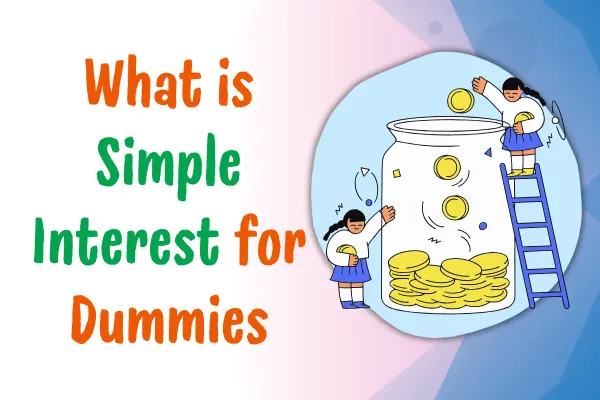Understanding the Basics of Simple Interest
To explain simple interest to a child, we need to start by making the concept relatable. Simple interest is the extra money you earn or pay when you borrow or save money for a certain period. Imagine if you loaned your toy to a friend, and after a week, they gave you your toy back plus one chocolate bar as a thank-you. That chocolate is like the interest!
When you save money in a piggy bank or at a bank, simple interest is the “thank-you gift” that grows your money. It’s based on how much you save (Principal), for how long (Time), and at what rate (Rate of Interest). The cool part? The longer you save, the more chocolates—or money—you can get back.

Importance of Teaching Financial Concepts Early
Kids grasp new concepts quickly, especially when they’re fun and interactive. Teaching simple interest early lays a foundation for financial literacy that will serve them throughout life. Learning about interest empowers kids to become thoughtful savers, understand loans, and even become mini-investors someday.
How Do You Explain Simple Interest to a Child?
Let’s make it simple. You can say:
“Simple interest is like a reward for saving money or letting someone use your money for a while.”
Break it down like this:
- Principal (P): The money you start with.
- Rate (R): How much you earn or pay every year (as a percent).
- Time (T): How long you save or borrow the money.
Simple Interest = (P × R × T) ÷ 100
Make sure to use everyday items to relate. “If you save $100 at 5% interest for 1 year, you get $5. So you now have $105!”
Using Real-Life Examples to Teach Simple Interest
The Lemonade Stand
Imagine your child wants to start a lemonade stand but doesn’t have enough money. You lend them $20. You agree they’ll give you back $22 in a month—$2 as interest. This shows how borrowing works and introduces the concept of repayment with interest.
The Toy Lending Scenario
If they lend a toy and expect a reward in return, they’re getting “interest” for lending something valuable.
Visual Aids and Tools for Better Understanding
Use charts showing how money grows. Apps like PiggyBot or Savings Spree visually demonstrate saving and earning. Interactive worksheets can make this learning journey both playful and memorable.
Engaging Activities to Reinforce Learning
Kids learn best by doing. Create a DIY game where they “invest” pretend money and earn interest over pretend weeks. Give them a worksheet where they calculate the extra money they earned each round. Use colorful stickers to represent money earned, which makes the process tangible and engaging.
Another fun activity is designing a “Savings Coloring Sheet”. Each time they reach a savings goal or interest amount, they get to color a section. This builds enthusiasm and confidence in their understanding.
Comparing Simple Interest with Compound Interest
Explain that simple interest is like getting the same amount of candy each day for lending a toy, while compound interest is like getting candy based on how many candies you already have. For now, kids should focus on simple interest—one step at a time!
By saying “Simple interest grows money like steps, while compound interest grows money like stairs with rockets,” you’re giving them a fun mental image.
Fun Ways to Memorize the Formula
Make up a rhyme:
“P times R times T, then divide by one hundred,
That’s how your money’s funded!”
Or sing it to a catchy tune like “Twinkle Twinkle Little Star.” Songs and rhymes can deeply embed the formula in memory.
When Should You Start Teaching This Concept?
Start teaching simple interest concepts once kids can understand basic math operations like multiplication and percentages. This is usually around ages 9–11. However, younger children can grasp the “why” even if not the “how” yet.
Use relatable, bite-sized concepts. Early exposure leads to better financial intuition later.

Common Mistakes to Avoid While Explaining Simple Interest
- Avoid being too abstract – Always use examples tied to their daily life.
- Don’t skip over the formula – Kids love decoding patterns, and it feels like a secret trick they now know.
- Don’t assume they understand “percent” – Take time to explain percentages as parts of 100 using coins or candies.
Simple Interest Formula Explained for Kids
Break it down:
If they invest $100 at a 5% rate for 2 years:
Simple Interest = (100 × 5 × 2) ÷ 100 = $10
So they get back $110. It’s math magic, and it feels like a reward for being smart with money.
Why Simple Interest is a Good Starting Point
Simple interest helps children:
- See the rewards of saving
- Understand delayed gratification
- Build the confidence to handle more complex money ideas later
Plus, it’s easy to apply in daily life scenarios.
Incorporating Technology in Teaching
Use apps like “Bankaroo” or “iAllowance” to simulate saving and earning interest. These interactive tools make the learning process feel like a game. They can track their goals, watch their “interest” grow, and stay engaged.
Storytelling to Teach Simple Interest
Create a bedtime story:
“Ella the Elephant saves her coins in a treasure chest. Each month, the chest gives her a new coin as a thank-you!”
Stories personalize concepts and make them memorable.
Using Board Games and Toys
Games like Monopoly are treasure troves of financial lessons. Introduce the concept of “rent” as a form of interest. Or create custom cards that give “bonus money” for saving.
Piggy banks with labels like “Save,” “Spend,” “Invest,” and “Interest” encourage divided thinking and planning.
Interactive Classroom Activities
Teachers can simulate a bank where students “deposit” points and earn interest over time. Make them fill out fake bank statements, write checks, and calculate their earnings weekly.
It’s a brilliant hands-on experience.
Simple Interest and Goal-Setting
Link saving with real goals:
“Save $50 for a game, and you’ll earn $5 more if you don’t touch it for 5 weeks.”
Now they’re motivated to wait—and they’re learning!
Parental Involvement in Financial Education
Parents should lead by example. Create a family savings jar where everyone contributes and earns “interest.” Use reward charts that add bonuses for saving consistently.
Make money a fun and safe topic at home.
Repetition and Reinforcement Techniques
Use weekly challenges like “Guess the Interest” or “What’s the Extra Money?” to encourage retention. Create flashcards that show scenarios for them to solve quickly.
Reinforcement through variety keeps learning dynamic.
Tracking Learning Progress
Give them a journal where they write down their savings and interest earned. They can decorate it, track goals, and take ownership of their progress.
Real-Life Benefits of Understanding Simple Interest
Understanding simple interest helps kids:
- Make smart decisions when saving
- Avoid being tricked by unfair loans
- Appreciate the value of delayed rewards
They start making better money choices early on.
Integrating Simple Interest in School Curriculum
Schools can include interest lessons in math and life skills classes. It complements arithmetic and financial literacy programs seamlessly.
Cultural and Global Context of Money Education
In countries like Japan and Australia, financial literacy starts early. We can adopt similar methods with story-based learning, hands-on activities, and play.
Building a Financial Vocabulary
Make a “Money Words Wall” where terms like Principal, Rate, and Interest are defined with illustrations.
Celebrating Financial Literacy Milestones
Celebrate every savings milestone! Whether with certificates, interest “badges,” or a mini financial party—reward their progress to keep them excited.
Linking Interest to Saving and Banking
Take them to a bank, open a savings account, and watch their face light up when they earn their first dollar of interest. It’s powerful.
Books and Resources for Kids
Some great books include:
- Money Ninja by Mary Nhin
- The Everything Kids’ Money Book by Brette Sember
These resources help extend learning beyond lessons.
What Teachers Can Do Differently
Make finance feel like play, not punishment. Use cartoons, songs, puzzles, and games.
The Role of Animations and Cartoons
YouTube has channels like “Smart Kids Finance” and “Cashville Kidz” that make interest fun through colorful animations.
Long-Term Impact of Early Financial Education
Kids who understand simple interest grow into adults who:
- Budget better
- Avoid debt traps
- Invest wisely
The earlier they learn, the stronger their future becomes.
FAQs
What is the easiest way to explain simple interest to kids?
Compare it to earning a treat for saving money over time or lending something valuable.
How early can a child learn about interest?
As early as 9 years old, especially if they understand multiplication and basic math.
Is it necessary to use formulas when teaching kids?
Yes, in a fun and simple way. They enjoy discovering patterns and solving small equations.
Are there any fun games for teaching simple interest?
Yes! You can create a mock bank or use board games with saving and earning elements.
Why not teach compound interest instead?
Compound interest is more complex. Simple interest lays the foundation for understanding that later.
Can simple interest be taught at home?
Absolutely! Through chores, allowance tracking, and goal-based saving challenges.
Conclusion
Explaining simple interest to a child is not only possible—it’s a joy. With stories, visuals, and hands-on play, children can grasp this key financial concept early on. The effort you invest today in teaching your child about simple interest can compound into a future of smart savings, confident decisions, and a rock-solid financial mindset.

